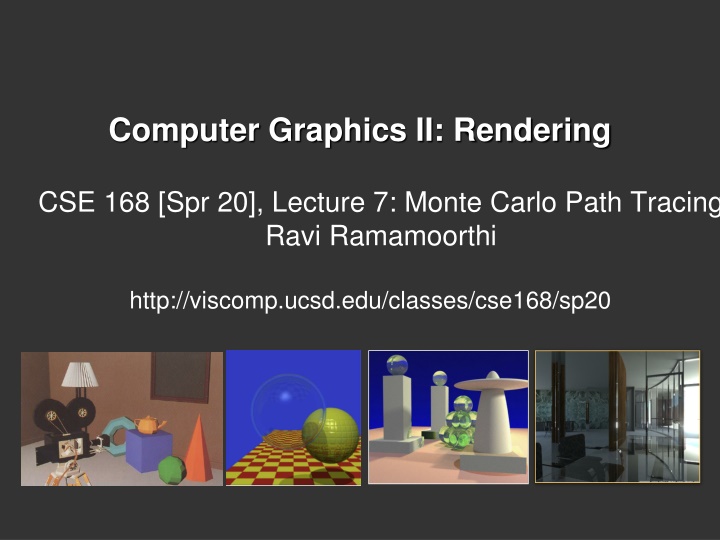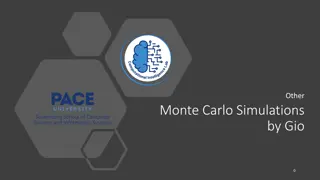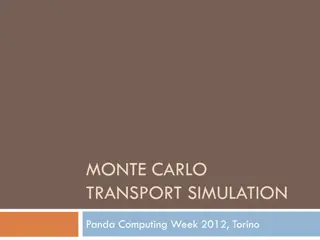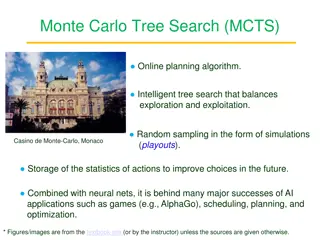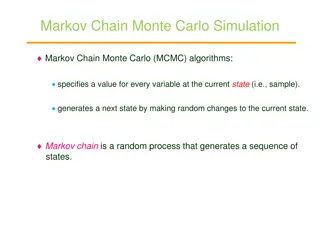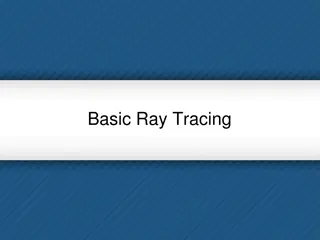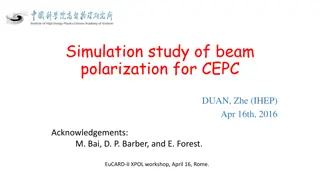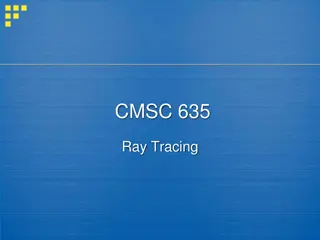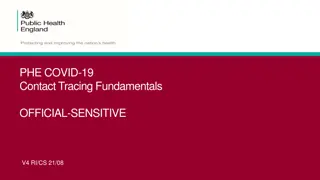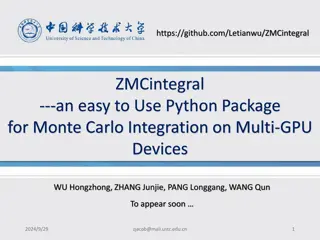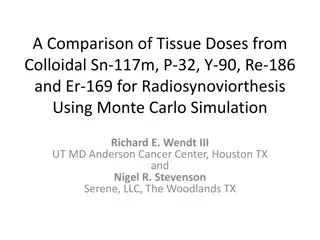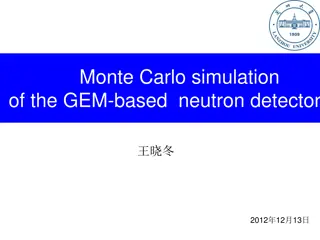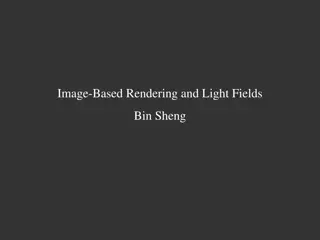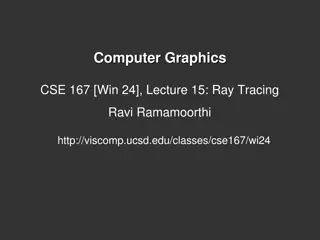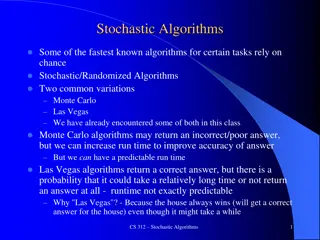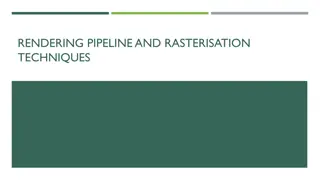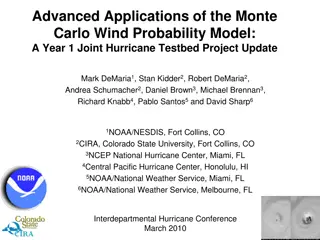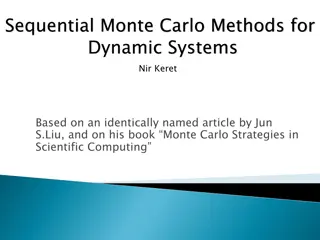Monte Carlo Path Tracing: Rendering Techniques & Applications
This content delves into Monte Carlo Path Tracing, a powerful method for rendering in computer graphics. Covering topics such as global illumination, sampling techniques, and advantages vs. disadvantages, this resource provides insights into integrating radiance for each pixel through random path sampling.
Download Presentation

Please find below an Image/Link to download the presentation.
The content on the website is provided AS IS for your information and personal use only. It may not be sold, licensed, or shared on other websites without obtaining consent from the author.If you encounter any issues during the download, it is possible that the publisher has removed the file from their server.
You are allowed to download the files provided on this website for personal or commercial use, subject to the condition that they are used lawfully. All files are the property of their respective owners.
The content on the website is provided AS IS for your information and personal use only. It may not be sold, licensed, or shared on other websites without obtaining consent from the author.
E N D
Presentation Transcript
Computer Graphics II: Rendering CSE 168 [Spr 20], Lecture 7: Monte Carlo Path Tracing Ravi Ramamoorthi http://viscomp.ucsd.edu/classes/cse168/sp20
To Do Homework 2 (direct lighting) due in a few days Next assignment path tracing (on edX edge). This lecture covers much of that material
Motivation General solution to rendering and global illumination Suitable for a variety of general scenes Based on Monte Carlo methods Enumerate all paths of light transport
Monte Carlo Path Tracing Big diffuse light source, 20 minutes Jensen
Monte Carlo Path Tracing 1000 paths/pixel Jensen
Monte Carlo Path Tracing Advantages Any type of geometry (procedural, curved, ...) Any type of BRDF (specular, glossy, diffuse, ...) Samples all types of paths (L(SD)*E) Accuracy controlled at pixel level Low memory consumption Unbiased - error appears as noise in final image Disadvantages (standard Monte Carlo problems) Slow convergence (square root of number of samples) Noise in final image
Monte Carlo Path Tracing Integrate radiance for each pixel by sampling paths randomly Specular Surface Light Eye Pixel x Diffuse Surface w )( w n)dw W Lo(x,w)= Le(x,w)+ fr(x, w ,w)Li(x,
Simple Monte Carlo Path Tracer Step 1: Choose a ray (u,v, , ) [per pixel]; assign weight = 1 Step 2: Trace ray to find intersection with nearest surface Step 3: Randomly choose between emitted and reflected light Step 3a: If emitted, return weight * Le Step 3b: If reflected, weight *= reflectance Generate ray in random direction Go to step 2
Sampling Techniques Problem: how do we generate random points/directions during path tracing and reduce variance? Importance sampling (e.g. by BRDF) Stratified sampling Eye x Surface
Outline Motivation and Basic Idea Implementation of simple path tracer Variance Reduction: Importance sampling Other variance reduction methods Specific 2D sampling techniques
Simplest Monte Carlo Path Tracer For each pixel, cast n samples and average Choose a ray with p=camera, d=( , ) within pixel Pixel color += (1/n) * TracePath(p, d) TracePath(p, d) returns (r,g,b) [and calls itself recursively]: Trace ray (p, d) to find nearest intersection p Select with probability (say) 50%: Emitted: return 2 * (Lered, Legreen, Leblue) // 2 = 1/(50%) Reflected: generate ray in random direction d return 2 * fr(d d ) * (n d ) * TracePath(p , d )
Simplest Monte Carlo Path Tracer For each pixel, cast n samples and average over paths Choose a ray with p=camera, d=( , ) within pixel Pixel color += (1/n) * TracePath(p, d) TracePath(p, d) returns (r,g,b) [and calls itself recursively]: Trace ray (p, d) to find nearest intersection p Select with probability (say) 50%: Emitted: return 2 * (Lered, Legreen, Leblue) // 2 = 1/(50%) Reflected: generate ray in random direction d return 2 * fr(d d ) * (n d ) * TracePath(p , d )
Simplest Monte Carlo Path Tracer For each pixel, cast n samples and average Choose a ray with p=camera, d=( , ) within pixel Pixel color += (1/n) * TracePath(p, d) TracePath(p, d) returns (r,g,b) [and calls itself recursively]: Trace ray (p, d) to find nearest intersection p Select with probability (say) 50%: Emitted: return 2 * (Lered, Legreen, Leblue) // 2 = 1/(50%) Reflected: generate ray in random direction d return 2 * fr(d d ) * (n d ) * TracePath(p , d ) Weight = 1/probability Remember: unbiased requires having f(x) / p(x)
Simplest Monte Carlo Path Tracer For each pixel, cast n samples and average Choose a ray with p=camera, d=( , ) within pixel Pixel color += (1/n) * TracePath(p, d) TracePath(p, d) returns (r,g,b) [and calls itself recursively]: Trace ray (p, d) to find nearest intersection p Select with probability (say) 50%: Emitted: return 2 * (Lered, Legreen, Leblue) // 2 = 1/(50%) Reflected: generate ray in random direction d return 2 * fr(d d ) * (n d ) * TracePath(p , d ) Path terminated when Emission evaluated
Arnold Renderer (M. Fajardo) Works well diffuse surfaces, hemispherical light
From CS 283(294) a few years ago Daniel Ritchie and Lita Cho
Advantages and Drawbacks Advantage: general scenes, reflectance, so on By contrast, standard recursive ray tracing only mirrors This algorithm is unbiased, but horribly inefficient Sample emitted 50% of the time, even if emitted=0 Reflect rays in random directions, even if mirror If light source is small, rarely hit it Goal: improve efficiency without introducing bias Variance reduction using many of the methods discussed for Monte Carlo integration last week Subject of much interest in graphics in 90s till today
Outline Motivation and Basic Idea Implementation of simple path tracer Variance Reduction: Importance sampling Other variance reduction methods Specific 2D sampling techniques
Importance Sampling Pick paths based on energy or expected contribution More samples for high-energy paths Don t pick low-energy paths At macro level, use to select between reflected vs emitted, or in casting more rays toward light sources At micro level, importance sample the BRDF to pick ray directions Tons of papers in 90s on tricks to reduce variance in Monte Carlo rendering Importance sampling now standard in production. I consulted on Pixar s system for upcoming movies
Importance Sampling Can pick paths however we want, but contribution weighted by 1/probability Already seen this division of 1/prob in weights to emission, reflectance =1 N W Yi=f(xi) f(x)dx Yi E(f(x)) N i=1 p(xi) x1 xN
Simplest Monte Carlo Path Tracer For each pixel, cast n samples and average Choose a ray with p=camera, d=( , ) within pixel Pixel color += (1/n) * TracePath(p, d) TracePath(p, d) returns (r,g,b) [and calls itself recursively]: Trace ray (p, d) to find nearest intersection p Select with probability (say) 50%: Emitted: return 2 * (Lered, Legreen, Leblue) // 2 = 1/(50%) Reflected: generate ray in random direction d return 2 * fr(d d ) * (n d ) * TracePath(p , d )
Importance sample Emit vs Reflect TracePath(p, d) returns (r,g,b) [and calls itself recursively]: Trace ray (p, d) to find nearest intersection p If Le = (0,0,0) then pemit= 0 else pemit= 0.9 (say) If random() < pemit then: Emitted: return (1/ pemit) * (Lered, Legreen, Leblue) Else Reflected: generate ray in random direction d return (1/(1- pemit)) * fr(d d ) * (n d ) * TracePath(p , d )
Importance sample Emit vs Reflect TracePath(p, d) returns (r,g,b) [and calls itself recursively]: Trace ray (p, d) to find nearest intersection p If Le = (0,0,0) then pemit= 0 else pemit= 0.9 (say) If random() < pemit then: Emitted: return (1/ pemit) * (Lered, Legreen, Leblue) Else Reflected: generate ray in random direction d return (1/(1- pemit)) * fr(d d ) * (n d ) * TracePath(p , d ) Can never be 1 unless Reflectance is 0
Outline Motivation and Basic Idea Implementation of simple path tracer Variance Reduction: Importance sampling Other variance reduction methods Specific 2D sampling techniques
More variance reduction Discussed macro importance sampling Emitted vs reflected How about micro importance sampling Shoot rays towards light sources in scene Distribute rays according to BRDF
One Variation for Reflected Ray Pick a light source Trace a ray towards that light Trace a ray anywhere except for that light Rejection sampling Divide by probabilities 1/(solid angle of light) for ray to light source (1 the above) for non-light ray Extra factor of 2 because shooting 2 rays
Russian Roulette Maintain current weight along path (need another parameter to TracePath) Terminate ray iff |weight| < const. Be sure to weight by 1/probability
Monte Carlo Extensions Unbiased Bidirectional path tracing Metropolis light transport Biased, but consistent Noise filtering Adaptive sampling Irradiance caching
Monte Carlo Extensions Unbiased Bidirectional path tracing Metropolis light transport Biased, but consistent Noise filtering Adaptive sampling Irradiance caching RenderPark
Monte Carlo Extensions Unbiased Bidirectional path tracing Metropolis light transport Biased, but consistent Noise filtering Adaptive sampling Irradiance caching Heinrich
Monte Carlo Extensions Unbiased Bidirectional path tracing Metropolis light transport Biased, but consistent Noise filtering Adaptive sampling Irradiance caching Unfiltered Filtered Jensen
Monte Carlo Extensions Unbiased Bidirectional path tracing Metropolis light transport Biased, but consistent Noise filtering Adaptive sampling Irradiance caching Fixed Adaptive Ohbuchi
Monte Carlo Extensions Unbiased Bidirectional path tracing Metropolis light transport Biased, but consistent Noise filtering Adaptive sampling Irradiance caching Jensen
Monte Carlo Path Tracing Image 2000 samples per pixel, 30 computers, 30 hours Jensen
Outline Motivation and Basic Idea Implementation of simple path tracer Variance Reduction: Importance sampling Other variance reduction methods Specific 2D sampling techniques
2D Sampling: Motivation Final step in sending reflected ray: sample 2D domain According to projected solid angle Or BRDF Or area on light source Or sampling of a triangle on geometry Etc.
Sampling Upper Hemisphere Uniform directional sampling: how to generate random ray on a hemisphere? Option #1: rejection sampling Generate random numbers (x,y,z), with x,y,z in 1..1 If x2+y2+z2 > 1, reject Normalize (x,y,z) If pointing into surface (ray dot n < 0), flip
Sampling Upper Hemisphere Option #2: inversion method In polar coords, density must be proportional to sin (remember d(solid angle) = sin d d ) Integrate, invert cos-1 So, recipe is Generate in 0..2 Generate z in 0..1 Let = cos-1 z (x,y,z) = (sin cos , sin sin , cos ) This is what you need to do for homework 3 (simple upper hemisphere sampling). Anything more advanced (importance sampling later in lecture) is extra (homework 4).
BRDF Importance Sampling Better than uniform sampling: importance sampling Because you divide by probability, ideally probability proportional to fr * cos i
BRDF Importance Sampling For cosine-weighted Lambertian: Density = cos sin Integrate, invert cos-1(sqrt) So, recipe is: Generate in 0..2 Generate z in 0..1 Let = cos-1 (sqrt(z))
BRDF Importance Sampling Phong BRDF: fr ~ cosn where is angle between outgoing ray and ideal mirror direction Constant scale = ks(n+2)/(2 ) Can t sample this times cos i Can only sample BRDF itself, then multiply by cos i That s OK still better than random sampling
BRDF Importance Sampling Recipe for sampling specular term: Generate z in 0..1 Let = cos-1 (z1/(n+1)) Generate in 0..2 This gives direction w.r.t. ideal mirror direction Convert to (x,y,z), then rotate such that z points along mirror dir.
Summary Monte Carlo methods robust and simple (at least until nitty gritty details) for global illumination Must handle many variance reduction methods in practice Importance sampling, Bidirectional path tracing, Russian roulette etc. Rich field with many papers, systems researched over last 10 years
